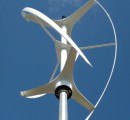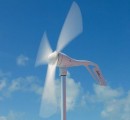Wind Mill Designing with Permanent Magnet Generators -II
In this post we will discuss two very important factors that define a windmill; its axis and its generator torque. The axis type of the windmill decides the whole process of capturing wind speed and the mechanism of converting it to electricity.
Axis
Vertical Axis Wind Turbines
VAWTs have become popular in recent times. Manufacturers claim that these designs are quiet, efficient, and economical. The rotor shaft in a VAWT is placed perpendicular to the ground. They can be used to generate electricity without getting bothered about placing them in the direction of the wind. These are Omni Directional. Hence they require less parts which makes them less costly and gives ease of maintenance.
They produce a good amount of torque. Its blades have a large surface area. Hence they can be coupled directly to pumps etc. Also they are designed to spin at much low speeds, hence they can function efficiently at higher wind speeds. This decreases noise and vibrations and provides stability.
Horizontal Axis Wind Turbines
HAWTs are the most common type of wind designs used today. In fact most grid connected commercial wind turbines are today designed with propeller-type rotors mounted on a horizontal axis on top of a vertical tower. These turbines need to be aligned with the direction of the wind, hence allowing the wind to flow parallel to the axis of rotation.
Upwind rotors need a yaw mechanism to keep the axis aligned with wind direction. Downwind rotors are placed on the lee side of the tower. A great disadvantage in this design is the fluctuations in the wind power due to the rotor passing through the wind shade of the tower which gives rise to more fatigue loads.
Generator Torque
With wind permanent magnet alternator, one can set the cut in speeds as well as the cut out speeds. Hence electricity can be generated at a variable speed. For example, suppose the turbine speed is 200 RPM at a torque of 40 NM. With permanent magnet generators, the torque generated will be around 90% of 40 NM at same RPM. Other machines are able to provide just around 70% of this torque.
